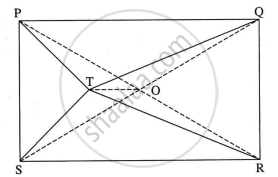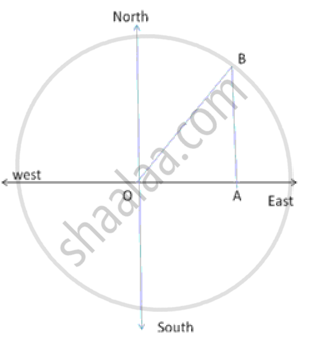Advertisements
Advertisements
Question
In the given figure, point T is in the interior of rectangle PQRS, Prove that, TS2 + TQ2 = TP2 + TR2 (As shown in the figure, draw seg AB || side SR and A-T-B)

Solution 1
Construction: Through T, draw seg AB II side SR such that A-T-B, P- A-S and Q-B-R.
Proof:
seg PS || seg QR ...(Opposite sides of rectangle)
∴ seg AS || seg BR ...(P-A-S and Q-B-R)
also seg AB || seg SR ...(Construction)
∴ `square` ASRB is a parallelogram ...((By definition)
∠ASR = 90° ...(Angle of rectangle PSRQ)
∴ `square` ASRB is a rectangle ...(A parallelogram is a rectangle, if one of its angles is a right angle.)
∠SAB = ∠ABR = 90° ...(Angle of a rectangle)
∴ seg TA ⊥ side PS and seg TB ⊥ side QR ...(1)
AS = BR ...(2) (Opposite sides of rectangle are equal)
Similarly, we can prove AP= BQ ...(3)
In ΔTAS,
∠TAS = 90° ...[From (1)]
∴ by Pythagoras theorem,
TS2 = TA2 + AS2 ...(4)
In ΔTBQ,
∠TBQ = 90° ...[From (1)]
∴ by Pythagoras theorem,
TQ2 = TB2 + BQ2 ...(5)
Adding (4) and (5), we get,
TS2 + TQ2 = TA2 + AS2 + TB2 + BQ2 ...(6)
In ΔTAP,
∠TAP = 90° ...[From (1)]
∴ by Pythagoras theorem,
TP2 = TA2 + AP2 ...(7)
In ΔTBR,
∠TBR = 90° ...[From (1)]
∴ by Pythagoras theorem,
TR2 = TB2 + BR2 ...(8)
Adding (7) and (8), we get
TP2 + TR2 = TA2 + AP2 + TB2 + BR2
∴ TP2 + TR2 = TA2 + BQ2 + TB2 + AS2 ...(9) [From (2) and (3)]
∴ from (6) and (g), we get,
TS2 + TQ2 = TP2 + TR2
Solution 2
Construction: Draw diagonals PR and QS and let them intersect at 0. Draw seg TO.

Proof: `square` PQRS is a rectangle ...(Given)
∴ PR=QS ...(Diagonals of rectangle are congruent)
Multiplying both the sides by `1/2`, we get,
`1/2`PR = `1/2`QS ...(1)
But, `1/2`PR = OP = OR ...(2)
and `1/2`QS = OS = OQ ...(3) [Diagonals of rectangle bisect each other]
∴ OP = OR = OS = OQ ...(4) [From (1), (2) and (3)]
In ΔTSQ,
seg TO is the median ...(By definition)
∴ by Apollonius theorem,
TS2 + TQ2 = 2TO2 + 2OQ2 ...(5)
In ΔPTR,
seg TO is the median ...(By definition)
∴ by Apollonius theorem,
TP2 + TR2 = 2TO2 + 2OR2
∴ TP2 + TR2 = 2TO2 + 2OQ2 ...(6) [From (4)]
∴ from (5) and (6), we get,
TS2 + TQ2 = TP2 + TR2
Notes
Students can refer to the provided solutions based on their preferred marks.
RELATED QUESTIONS
ABCD is a rectangle whose three vertices are B (4, 0), C(4, 3) and D(0,3). The length of one of its diagonals is
(A) 5
(B) 4
(C) 3
(D) 25
In Fig., ∆ABC is an obtuse triangle, obtuse angled at B. If AD ⊥ CB, prove that AC2 = AB2 + BC2 + 2BC × BD
Sides of triangle are given below. Determine it is a right triangle or not? In case of a right triangle, write the length of its hypotenuse. 7 cm, 24 cm, 25 cm
Identify, with reason, if the following is a Pythagorean triplet.
(4, 9, 12)
O is any point inside a rectangle ABCD.
Prove that: OB2 + OD2 = OC2 + OA2.
The sides of a certain triangle is given below. Find, which of them is right-triangle
16 cm, 20 cm, and 12 cm
In triangle PQR, angle Q = 90°, find: PR, if PQ = 8 cm and QR = 6 cm
Find the Pythagorean triplet from among the following set of numbers.
2, 6, 7
From the given figure, find the length of hypotenuse AC and the perimeter of ∆ABC.
A man goes 10 m due east and then 24 m due north. Find the distance from the straight point.
A right triangle has hypotenuse p cm and one side q cm. If p - q = 1, find the length of third side of the triangle.
Two poles of height 9m and 14m stand on a plane ground. If the distance between their 12m, find the distance between their tops.
AD is perpendicular to the side BC of an equilateral ΔABC. Prove that 4AD2 = 3AB2.
Two trains leave a railway station at the same time. The first train travels due west and the second train due north. The first train travels at a speed of `(20 "km")/"hr"` and the second train travels at `(30 "km")/"hr"`. After 2 hours, what is the distance between them?
In triangle ABC, line I, is a perpendicular bisector of BC.
If BC = 12 cm, SM = 8 cm, find CS
Foot of a 10 m long ladder leaning against a vertical wall is 6 m away from the base of the wall. Find the height of the point on the wall where the top of the ladder reaches.
In ∆PQR, PD ⊥ QR such that D lies on QR. If PQ = a, PR = b, QD = c and DR = d, prove that (a + b)(a – b) = (c + d)(c – d).
In a quadrilateral ABCD, ∠A + ∠D = 90°. Prove that AC2 + BD2 = AD2 + BC2
[Hint: Produce AB and DC to meet at E.]
Two poles of 10 m and 15 m stand upright on a plane ground. If the distance between the tops is 13 m, find the distance between their feet.
